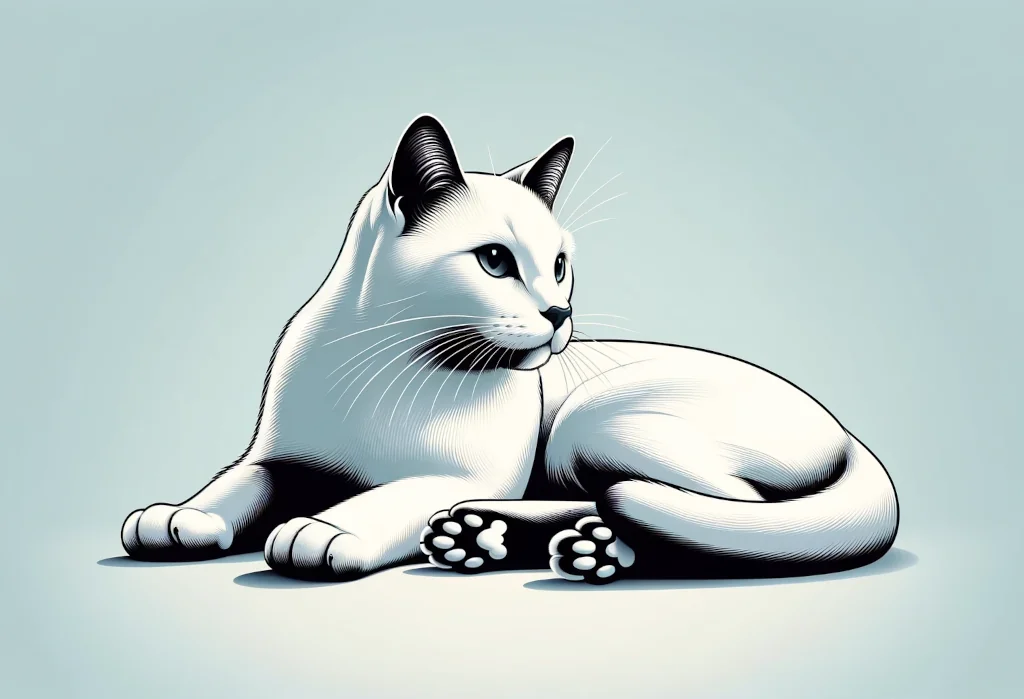Ever tried to solve a puzzle that seems straightforward but leaves you scratching your head? That’s how some cat owners feel when they notice their pure white kitties suddenly sporting black paws. It’s like a magic trick with no magician in sight.
In this blog post, we’re giving you the scoop on those mysteriously dark paws, unraveling the genetics, and revealing the breeds where this phenomenon is most common. By the end, you’ll know exactly why some white cats have black paws and which breeds to look out for.
Quick Takeaways:
- White cats with black paws often have a genetic trait called “points,” common in Siamese, Birman, Ragdoll, and Himalayan breeds.
- Environmental factors like temperature and sun exposure can slightly influence coat color, but not change paw color from white to black.
- Diet and hydration play key roles in maintaining fur’s health and luster, although they don’t directly affect paw coloration.
Why Do Some White Cats Have Black Paws?
Ever wonder why some white cats sport adorable black paws, almost as if they’ve dipped their toes in ink? The answer lies in the fascinating world of genetics. Cats, like many other creatures, have a gene for pigmentation. This doesn’t just stop at the color of their fur; it extends to their skin as well.
In the realm of feline genetics, there’s a quirky trait known as “points,” seen in breeds like the Siamese. These points refer to the cooler parts of a cat’s body – the ears, tail, and yes, the paws, where the color concentrates more deeply. The reason? A temperature-sensitive enzyme that dictates pigment development in these areas, leading to warmer parts of their body staying lighter (like their torso), and the cooler extremities getting darker.
However, not all white cats with black paws fall strictly into the category of pointed breeds. In some instances, it’s a simple case of genetic diversity giving our feline friends those charmingly mismatched socks.
Which Breeds Are More Likely to Have This Coloration?
When it comes to spotting a white cat with black paws, your first suspects might be the pointed breeds. Let’s take a closer look:
- Siamese: The poster child for pointed patterns, Siamese cats flaunt coloration on their extremities, including their paws.
- Birman: Similar to the Siamese but fluffier, Birmans also show this unique trait, with a stark contrast between their white bodies and darker points.
- Ragdoll: Known for their striking blue eyes and gentle demeanor, Ragdolls often have this coat pattern, with color concentrated on their ears, face, and, notably, paws.
- Himalayan: A crossbreed between Siamese and Persians, Himalayans inherit the pointed gene, displaying white coats with contrasting extremities.
However, surprises always exist, and you might find a non-pointed breed sporting a pair of dark paws. This variety often stems from a unique genetic blueprint or a nod to mixed ancestry.
How Does Environment Influence Coat Color?
Believe it or not, the environment plays a pivotal role in the development of a cat’s coat color, especially in those with temperature-sensitive pigmentation. Here’s how:
- Temperature: The reason pointed cats have darker extremities is that these areas are cooler. This is why kittens born into colder environments may develop a slightly darker coat than they would in a warmer setting.
- Sun Exposure: Just like in humans, sun exposure can slightly alter a cat’s fur color. Cats spending more time lounging in sunny spots may experience a subtle lightening of their coat.
- Age: As cats age, enzymatic reactions in their bodies change, which can slightly alter fur color. So, a cat with stark black paws in its youth might see a softening of color as it grows older.
A fascinating tidbit that most folks miss is this: specific nutritional elements can also influence coat color to a degree. For example, a diet rich in certain amino acids can slightly deepen the pigment in a cat’s fur, potentially making those black paws stand out even more. While not a dramatic change, it’s an intriguing insight into how what a cat eats can touch even the tips of their toes.
Remember, while genetics lays the groundwork for our furry friends’ appearance, a combination of environmental and even dietary factors can throw in a twist or two, making every cat astonishingly unique.
Can Diet or Health Impact Paw Coloration?
It’s a question that tickles the curiosity of many cat owners: can diet or health steer the ship when it comes to the color of our furry friends’ paws, especially those pristine white cats that sport the mysterious black pads? While genetics and environment hoist the main sails in determining fur and paw coloration, there’s more under the sun than meets the eye. Let’s dive in and fish out the facts from fiction.
The Role of Diet in Fur and Paw Coloration
First off, it’s crucial to acknowledge that a cat’s base coat and paw color are anchored in their genes. However, diet plays a supporting role, a bit like the wind that can change the direction of a sail. A well-balanced diet is essential for maintaining the lustrous sheen and health of a cat’s fur, but can it turn a white cat’s paws black? Not quite. However, nutritional deficiencies can lead to a dull coat and potentially affect the pigmentation, making the colors seem less vibrant.
Omega-3 and Omega-6 Fatty Acids: These are the masts of a healthy coat. They keep a cat’s fur shiny, and while they don’t change colors, they ensure the colors shine in their truest form. Foods rich in these fatty acids, like certain types of fish or supplements, could be the secret to maintaining that glossy look.
Vitamins and Minerals: A lack of certain vitamins and minerals can lead to pigmentation loss and affect overall health. While not directly impacting paw color, deficiencies can make a cat’s coat look less vibrant.
Unique Insight: One overlooked aspect that many miss is how a cat’s hydration level can affect their skin and fur health. Cats that don’t drink enough water may end up with dry skin, which can, in turn, affect the lustre of their fur. Encouraging hydration through wet food diets or water fountains can thus play a crucial role in maintaining their coat and skin health, indirectly supporting the natural coloration.
Health Issues That May Affect Coloration
When it comes to health influencing color, it’s a different ball game. Certain conditions can lead to discolorations in a cat’s fur, but changes in paw pad color are less common and usually signal something more specific.
Vitiligo: While rare, vitiligo can cause a loss of pigmentation in both a cat’s fur and skin, which theoretically could affect paw pads. However, it’s more likely to see this as random white patches across their coat.
Pododermatitis: Inflammation of the paw can lead to a change in color, but it’s usually redness due to infection or irritation, not a shift from white to black.
Environmental Factors and Physical Stress
It’s worth noting that environmental factors, such as sun exposure, can also influence fur color. Prolonged sun exposure could lead to a slight darkening of the fur in some white cats, but it won’t specifically target their paws, leaving those cute black pads purely down to genetics.
In conclusion, while diet and health are paramount to a cat’s overall fur luster and well-being, they don’t play captain when it comes to changing a white cat’s paw color to black. This trait is largely genetic. So, if your feline has those adorable black paws, it’s thanks to their genetic treasure map. Keep focusing on providing a balanced diet, fresh water, and regular vet check-ups to ensure your cat remains the picture of health, no matter the color of their paws.
Alex, a passionate animal lover, has experience in training and understanding animal behavior. As a proud pet parent to two dogs and three cats, he founded AnimalReport.net to share insights from animal experts and expand his knowledge of the animal kingdom.










